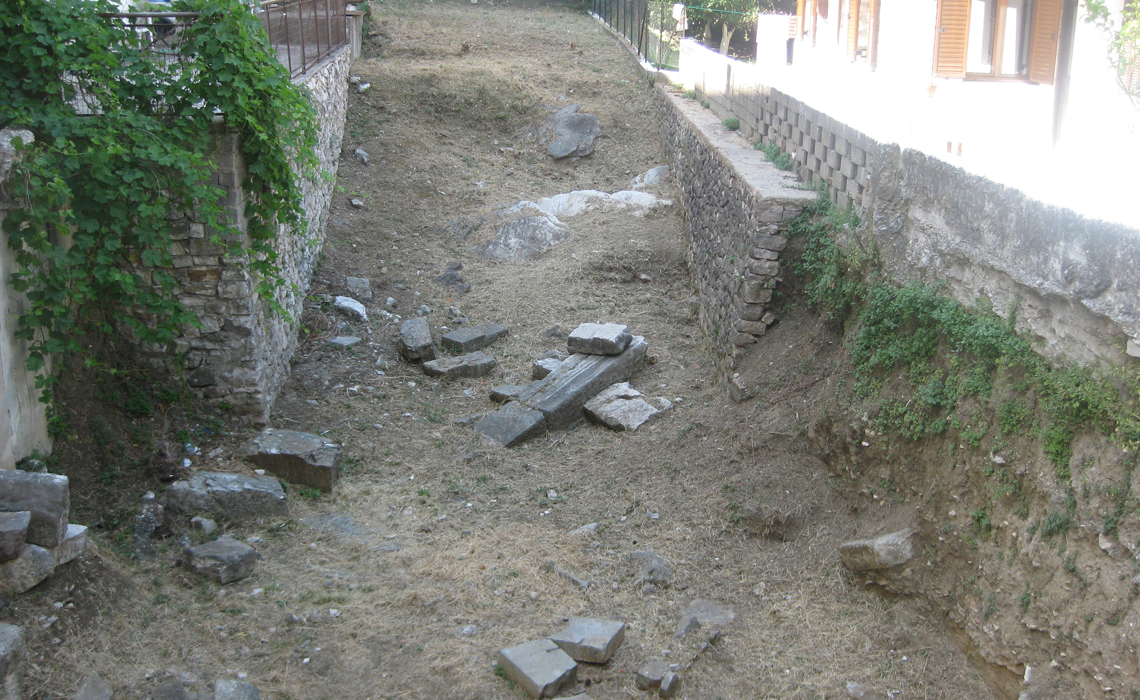
The big theater of ancient Amvracia was discovered in 1981 during excavation works to lay foundation of a building in a plot of land in Tsakalov Street, within the urban plan of the city of Arta. It was found within the ancient city walls, on a low hillside, where the Late Archaic temple of Apollo stands.
The monument is preserved in fragments, since its largest part is covered by the adjacent buildings and the streets Tsakalov and Maximus Graecus. More specifically, part of the orchestra, the cavea and the stage have been revealed..
From the cavea, which is oriented to the North, some of the bases of the seats and elongated limestone arranged radially are preserved. The main seats may have been made of wood and for they laid on natural rock, carved for this purpose. From the West, the cavea was supported by a very strong retaining wall, 0.90 m. wide and 5 m. long when revealed, which was made of limestone blocks.
The orchestra is defined by a stone arch, 0.65 m. wide with an estimated diameter at about 9 m. Until now, no sewer system has been discovered.
From the stage, a part of the stylobate of the proscenium, as well as a small part of the toichobate have been revealed.
Excavator P. Karantzenis dates the big theater of ancient Amvracia from the the late 4th to the early 3rd century BC. At the same period it is estimated that the small theater of the ancient city was also built.
Big Theater of Ancient Amvracia
Theater
The theater was built between the late 4th cent. BC and the early 3rd century BC on a low hillside within the walls of the ancient city.
Documentation with images and plans (archives of the 33rd Ephorate of Prehistoric and Classical Antiquities).
Tsakalov Street, City of Arta, Region of Arts.
Early 4th – late 3rd c. BC
The big theater of ancient Amvracia was discovered in 1981 during excavation works to lay foundation of a building in a plot of land in Tsakalov Street, within the urban plan of the city of Arta. It was found within the ancient city walls, on a low hillside, where the Late Archaic temple of Apollo stands.
The monument is preserved in fragments, since its largest part is covered by the adjacent buildings and the streets Tsakalov and Maximus Graecus. More specifically, part of the orchestra, the cavea and the stage have been revealed..
From the cavea, which is oriented to the North, some of the bases of the seats and elongated limestone arranged radially are preserved. The main seats may have been made of wood and for they laid on natural rock, carved for this purpose. From the West, the cavea was supported by a very strong retaining wall, 0.90 m. wide and 5 m. long when revealed, which was made of limestone blocks.
The orchestra is defined by a stone arch, 0.65 m. wide with an estimated diameter at about 9 m. Until now, no sewer system has been discovered.
From the stage, a part of the stylobate of the proscenium, as well as a small part of the toichobate have been revealed.
Excavator P. Karantzenis dates the big theater of ancient Ambracia from the the late 4th to the early 3rd century BC. At the same period it is estimated that the small theater of the ancient city was also built.
The monument is preserved in fragments, since its largest part is covered by the adjacent buildings and the streets Tsakalov and Maximus Graecus.
Cleanings and deforestations take place every year.
The extremely fragmental preservation of the monument does not allow it to be visited by the general public.
The monument belongs to the jurisdiction of the Ministry of Culture & Tourism / 33rd Ephorate of Prehistoric and Classical Antiquities.
The monument belongs to the jurisdiction of the Ministry of Culture & Tourism / 33rd Ephorate of Prehistoric and Classical Antiquities.
39.161454°
20.982218°
25 μ.
38.080325,23.733298